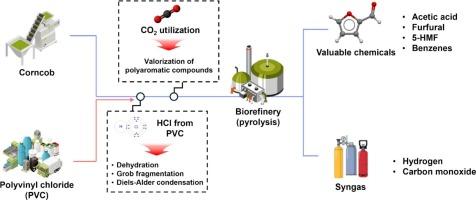聚氯乙烯在生物质热化学转化中的催化应用
IF 13.2
1区 工程技术
Q1 ENGINEERING, CHEMICAL
引用次数: 0
摘要
生物炼制是石化工业系统的可持续替代品。然而,它们的实际实施受到了环境和经济挑战的限制,这些挑战与它们对严酷的均相催化剂的依赖有关。本研究探讨了废聚氯乙烯(PVC)在玉米芯生物炼制中作为潜在催化剂的利用。PVC和玉米芯混合物样品的热重分析显示,热降解曲线与预测结果不同,表明改变了反应途径。由于pvc衍生的HCl与玉米芯衍生物之间的反应,与玉米芯热解相比,共热解的H2生成率提高了120 %。气体监测实验表明,在360 °C的温度下,PVC产生的HCl在催化生物质转化为糠醛、左旋葡萄糖酮和5-羟甲基糠醛等有价值的化学物质方面发挥了关键作用。特别是,与玉米芯热解相比,PVC和玉米芯以1:1的混合比例共热解可使糠醛收率提高约1,700 %。此外,co2辅助热解减少了多芳烃的生成,同时促进了单芳烃和合成气的生成。这些发现表明,PVC和CO2在玉米芯热解过程中具有提高生物炼制整体效率和减少污染物产生的潜力,为可持续生物炼制发展提供了一条有希望的途径。本文章由计算机程序翻译,如有差异,请以英文原文为准。

Catalytic application of polyvinyl chloride in thermochemical conversion of biomass
Biorefineries are sustainable alternatives to petrochemical-based industrial systems. However, their practical implementation has been constrained by the environmental and economic challenges associated with their reliance on harsh homogeneous catalysts. This study explored the utilization of wasted polyvinyl chloride (PVC) as a potential catalyst in a corncob biorefinery. Thermogravimetric analysis of the PVC and corncob mixture samples revealed thermal degradation profiles distinct from the predicted outcomes, indicating modified reaction pathways. Co-pyrolysis also enhanced H2 generation by 120 % compared to corncob pyrolysis owing to the reaction between PVC-derived HCl and corncob derivatives. Gas monitoring experiments demonstrated that HCl generated from PVC played a critical role in catalyzing biomass conversion into valuable chemicals such as furfural, levoglucosenone, and 5-hydroxymethylfurfural at temperatures <360 °C. Especially, co-pyrolysis of PVC and corncob at a 1:1 blending ratio increased furfural yield by approximately 1,700 % compared to corncob pyrolysis. Furthermore, CO2-assisted pyrolysis reduced polyaromatic hydrocarbon formation while enhancing the generation of monoaromatic hydrocarbon and syngas. These findings demonstrate the potential of PVC and CO2 in corncob pyrolysis to enhance overall biorefinery efficiency and mitigate pollutant generation, offering a promising pathway for sustainable biorefinery development.
求助全文
通过发布文献求助,成功后即可免费获取论文全文。
去求助
来源期刊

Chemical Engineering Journal
工程技术-工程:化工
CiteScore
21.70
自引率
9.30%
发文量
6781
审稿时长
2.4 months
期刊介绍:
The Chemical Engineering Journal is an international research journal that invites contributions of original and novel fundamental research. It aims to provide an international platform for presenting original fundamental research, interpretative reviews, and discussions on new developments in chemical engineering. The journal welcomes papers that describe novel theory and its practical application, as well as those that demonstrate the transfer of techniques from other disciplines. It also welcomes reports on carefully conducted experimental work that is soundly interpreted. The main focus of the journal is on original and rigorous research results that have broad significance. The Catalysis section within the Chemical Engineering Journal focuses specifically on Experimental and Theoretical studies in the fields of heterogeneous catalysis, molecular catalysis, and biocatalysis. These studies have industrial impact on various sectors such as chemicals, energy, materials, foods, healthcare, and environmental protection.
 求助内容:
求助内容: 应助结果提醒方式:
应助结果提醒方式:


